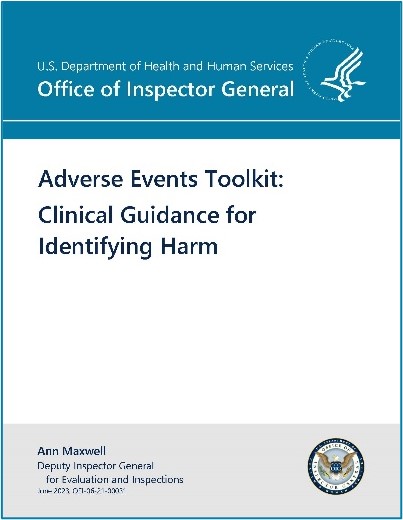Adverse Events Toolkits: Medical Record Review Methodology and Clinical Guidance for Identifying Patient Harm
What are the Adverse Events (AE) Toolkits?
The AE toolkits are technical resources to assist the health care community, government agencies, and researchers in identifying and measuring adverse events in hospitals or other inpatient settings. They are based on the expertise the Office of Inspector General (OIG) acquired conducting seven medical record reviews over the past 15 years to identify and categorize adverse events. Adverse events are patient harm events that occur due to medical care or lack of care and are not caused by underlying disease.
Why did OIG create the AE Toolkits?
Protecting patients from harm is a goal shared by OIG and the health care community. We created the AE toolkits to advance patient safety both through a discussion of methodological considerations when designing studies about patient harm and by providing specific clinical guidance to facilitate medical record reviews. Although we do not expect hospitals and researchers to employ our medical record review process in its entirety, we believe they may find value in adapting OIG's methods and guidance to identifying and tracking harm events in their facilities. Effectively identifying events and tracking the rate of harm helps health care providers understand the extent of patient harm, the types of harm that occur, and how to prevent the recurrence of future harm.
What do the AE Toolkits include?
The AE toolkits includes two documents: (1) a summary of our methodological approach to identifying and categorizing patient harm and (2) a set of clinical guidance we used to decide whether events counted as patient harm. These tools should be considered in tandem and may be adapted in part or in whole for use in other medical record review projects.

|
The Medical Record Review Methodology toolkit provides an explanation of the OIG methodology, including details about our definition of patient harm and how we categorized events by severity and preventability. It also includes tips on overcoming common challenges (such as complex cases) and quality assurance. |

|
The Clinical Guidance toolkit is a compendium of guidance we developed or adopted for assessing the care associated with 29 specific conditions and injuries. For each condition, we discuss how we determined whether the condition was the result of harm and whether it could have been prevented. We also include information about the hospital trigger tool reviewers used to screen for adverse events and suggestions for finding and recording key information. |
How to use the AE Toolkits
The two AE Toolkits include hyperlinks throughout to facilitate navigation and allow users to quickly identify and review the information that is most appropriate and useful given their specific needs and interests. The documents are presented as "pick and choose" resources to assist users in developing or updating their own medical record review procedures. The toolkits are not intended to be used to determine compliance with any laws, regulations, or other guidance.
Notice
This report may be subject to section 5274 of the National Defense Authorization Act Fiscal Year 2023, 117 Pub. L. 263.
